
What is the all-time best dunking cookie? Italian biscotti. Whether it's a glass of sweet wine or a mug of steaming coffee, biscotti's firm, crunchy texture stands up to dunking like no other cookie I know.
Biscotti, (pronounced bis-caught-tee), have been around since Roman antiquity. The name is from the Latin biscoctus, meaning "twice-baked," since they were baked twice in the oven. Originally, biscotti was a practical food; because they were dry and sturdy, they were easily transportable for long journeys.
It wasn't until the Renaissance in Tuscany, that biscotti became considered a treat. They were served and often dunked in wine, such as vin santo. Because of biscotti's hard, crunchy texture, people eventually people began dunking them in hot drinks such as coffee as well.
Though original Tuscan biscotti were made with almonds, today's biscotti come in an endless array of flavors. Some are made with anise, others with coffee. Many are studded with nuts and dried fruit while others are dipped in chocolate. There really is a biscotti to please everyone.
 If you're looking for a fool-proof basic, traditional Italian almond biscotti recipe, then you're in luck. Today I'm sharing my mom's recipe for Traditional Italian Almond Biscotti that are satisfyingly firm rather than jaw-breakingly hard and are chock-full of toasted whole almonds and laced with fragrant orange zest. They're our entry for Eat Christmas cookies, which is running through December 21st. Check out the delicious entries here.
If you're looking for a fool-proof basic, traditional Italian almond biscotti recipe, then you're in luck. Today I'm sharing my mom's recipe for Traditional Italian Almond Biscotti that are satisfyingly firm rather than jaw-breakingly hard and are chock-full of toasted whole almonds and laced with fragrant orange zest. They're our entry for Eat Christmas cookies, which is running through December 21st. Check out the delicious entries here.Biscotti are really easy to make. I swear. And the more you make them, the easier they become, since you'll develop a feel for the dough and the texture. Once you get the hang of making biscotti, feel free to adapt this recipe. For example make a festive Christmas biscotti by replacing almonds with pistachios and adding dried cranberries or cherries; or dip them in chocolate like my mother-in-law does.
Now here's how to make traditional Italian biscotti:

Work the batter together with lightly floured hands. At first the mixture will be sticky and crumbly, but persevere. Keep squeezing the batter with your hands until a dough starts to form.
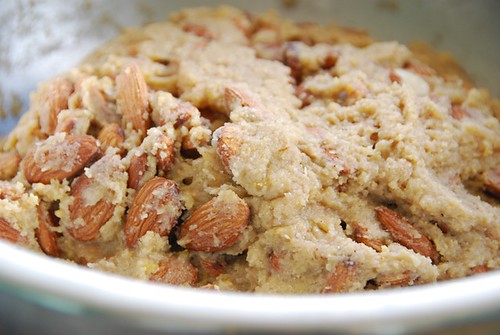
After a few minutes, the finished dough should be firm and smooth.
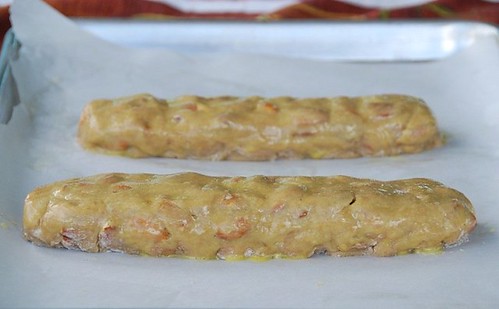
Using your hands, form the dough into logs, then brush with an egg wash, which will render the cookies shiny and golden.
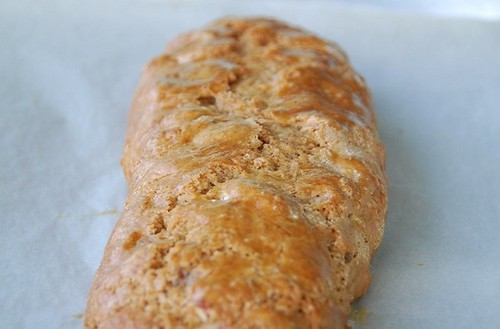
Baked loaves should be cooled for approximately 20 minutes before slicing.
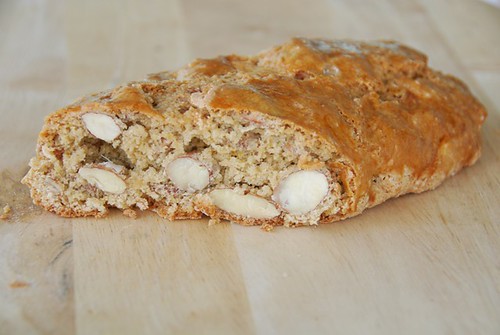
As seen above, biscotti are still soft when taken out of the oven. That's where the "twice baked" part comes in.
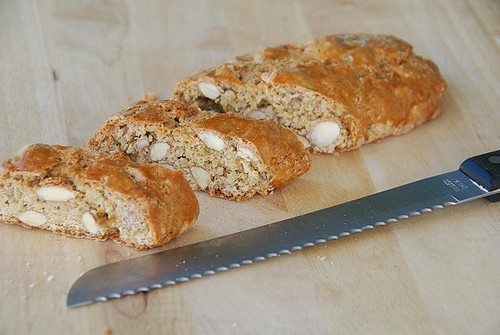
Slice the biscotti with a serrated knife by gently sawing in a back-and-forth motion to avoid breaking the cookies. Then place slices on their sides back on the baking sheets. Now either bake them in a heated oven again for 10-to 20 minutes or turn off the heat and let the biscotti stay inside the warm oven from 30--60 minutes. The longer they stay, the harder they will become. Cool biscotti completely before storing in an air-tight container, preferably a tin, which helps keep them crisp. Stored properly, biscotti will last up to a month.
Of course, if you're like me, you won't have any biscotti left after about three days.
Traditional Italian Almond Biscotti
My mom's almond biscotti are satisfyingly firm rather than jaw-breakingly hard and are chock-full of toasted whole almonds and laced with fragrant orange zest. They are ideal for dunking in a mug of hot coffee.
Makes 36 (3/4 inch-wide cookies)
Print recipe only here.
3 cups whole almonds
1 cup granulated sugar
1 cup light brown sugar
1/2 teaspoon ground cinnamon
2 teaspoons baking powder
2 1/2 cups all-purpose flour
3 jumbo eggs
1 teaspoon pure vanilla extract
zest of 1 large orange (about 1 -2 teaspoons)
plus one egg, lightly beaten for brushing tops of loaves
Preheat oven to 350 degrees F. Line two large sheets with parchment paper.
Place almonds in a single layer on a baking sheet and toast in the oven at 350 degrees F. for 10 minutes. Remove and set aside.
In a large bowl, hand mix toasted almonds, sugars, cinnamon, baking powder, and flour.
In a small bowl, whisk eggs. Add the vanilla and orange zest and whisk until well blended. Add to the flour mixture. Work the batter together with lightly floured hands. The mixture will be sticky, but persevere. Keep squeezing the batter with your hands, until a dough starts to form. Once the dough is firm, form a ball. Divide the ball into four equal pieces.
On a lightly floured surface place one piece of dough, and using your hands, roll into a log shape that is approximately 8 inches long, 2 inches wide, and 3/4 of an inch high. Repeat with remaining three pieces of dough. Place two logs per baking sheet.
Bake for 40 minutes, or until the tops of the loaves are shiny and deep golden. Cool on a rack for about 20 minutes before slicing. Place a loaf on a cutting board, and using a large serrated knife, slice cookies 3/4 of an inch thick on the diagonal. If the cookie is crumbling, then let it cool a few more minutes. Don't let it rest too long, however, or they could become too hard to slice. Place slices on their sides back on to the baking sheets; place in the still warm oven with the temperature off and the door closed for 30-60 minutes. The longer they stay in the oven, the harder they will become. Remove from oven and cool completely before storing in an air-tight container, preferably a tin, which helps keep them crisp. Stored properly, biscotti will last up to a month.
You might also like:
 Italian Pignoli (Pine Nut) Cookies
Italian Pignoli (Pine Nut) Cookies How to Make Italian Pizzelle Cookies in 5 Easy Steps
How to Make Italian Pizzelle Cookies in 5 Easy Steps Save This Page on Del.icio.us
Save This Page on Del.icio.us